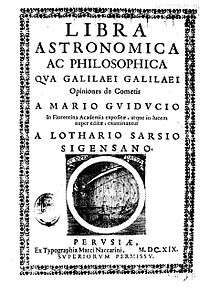Orazio Grassi

Orazio Grassi, S.J. (1 May 1583 – 23 July 1654), was an Italian Jesuit priest, who is best noted as a mathematician, astronomer and architect. He was one of the authors in controversy with Galileo Galilei on the nature of comets. His writings against Galileo were published under the pseudonym Sarsi.[1]
Life
Grassi was born in Savona, then part of the Republic of Genoa. He entered the novitiate of the Society of Jesus at the Church of Sant'Andrea al Quirinale in Rome in 1600. Following his profession of his first religious vows in 1603, he began studies at the Roman College, there taking courses in philosophy, theology and mathematics. Among his professors were the noted German Jesuit mathematicians, Christopher Clavius, Christoph Grienberger and Odo van Maelcote. He continued his studies there until 1610.
In response to Galileo's speculations regarding the appearance of three comets in 1618, and their origins, Grassi's treatise Libra astronomica ac philosophica was published under a pseudonym of Lotario Sarsi Sigensano (an anagram of Horatius Grassius Salonensis, his name in Latin). In it he supported the theories of Tycho Brahe, which were acceptable to the Catholic Church. Sarsi published a further tract against Galileo entitled Ratio ponderum librae et simbellae. While Libra focused on mainly astronomical issues, Ratio focused on doctrinal issues. Writes Redondi:
- ... unlike The Assayer, which had recourse to the lethal polemical weapons of satire and the new philosophy, the Ratio used those no-less-lethal weapons of doctrinal and dialectical retort based on religious and philosophical orthodoxy. (Redondi p. 191)
In 1614 Grassi was assigned to serve as Jesuit college in Genoa in the capacity of assistant Master of novices. He served in that position for two years, before being named as to the faculty of the Roman College as a professor of mathematics. During that period, his research focused on pure mathematics, as well as on optics and architecture. In 1617 he published a series of lectures he had given on the eye, De iride disputatio optica, under the pseudonym of Galeazzo Mariscotto, as well as the Tractatus tres de sphera, de horologis ac de optica. He pronounced solemn vows in the Society in 1618, at which time he received Holy Orders as a priest, following which he was given the chair in mathematics. He held this position until 1628.
Grassi published his work on the movement of the sun, In primum librum de architectura M. Vitruvii et in nonum eiusdem De horologiorum solarium descriptione duo brevissimi tractati in 1624.
In the field of architecture, Grassi supervised the construction of the Church of Sant'Ignazio in Rome, adjacent to the Roman College.[2]
Grassi died in Rome in 1654.
References
- ↑ Pietro Redondi, Galileo: heretic, Princeton University Press, 1987. p. 196
- ↑ Papagno, Simona. "Uno schizzo inedito del Padre Grassi per la lanterna di Sant'Ignazio (Roma)". Pontificia Università Gregoriana (in Italian).